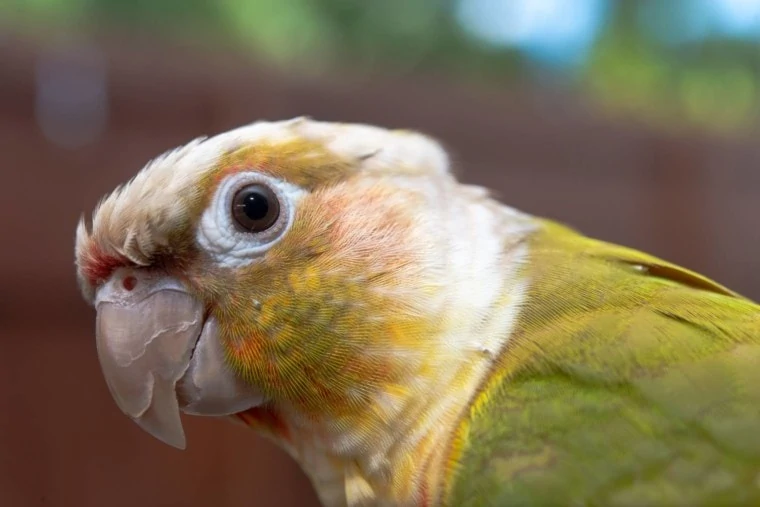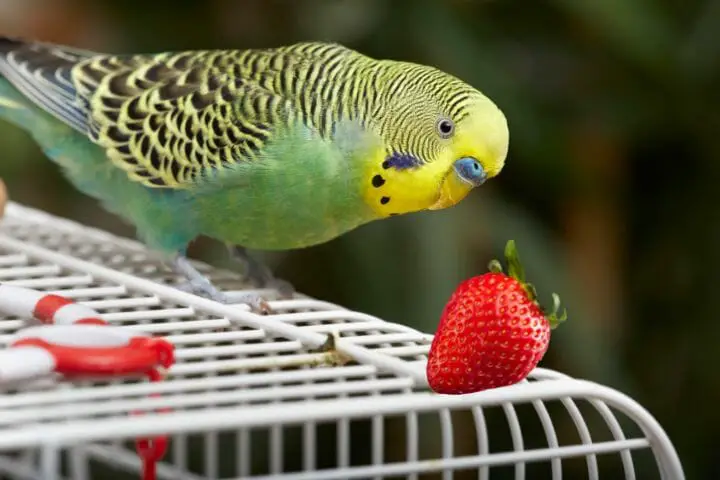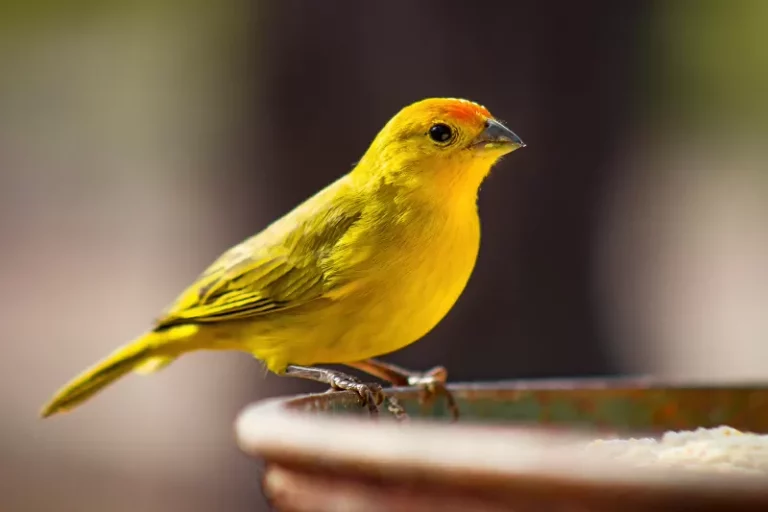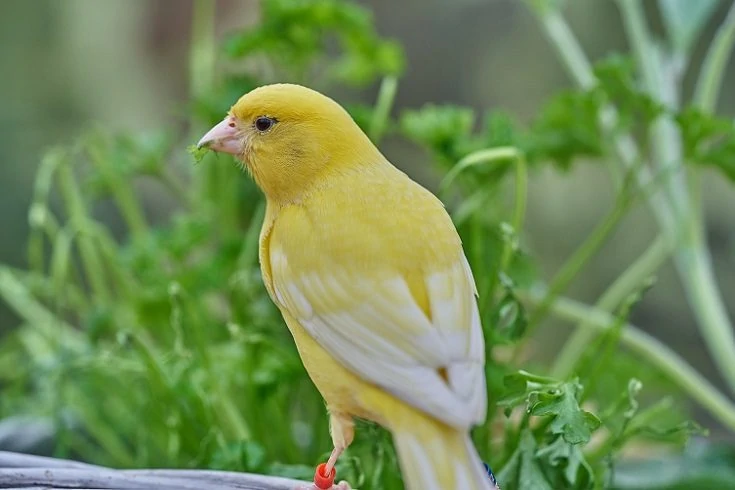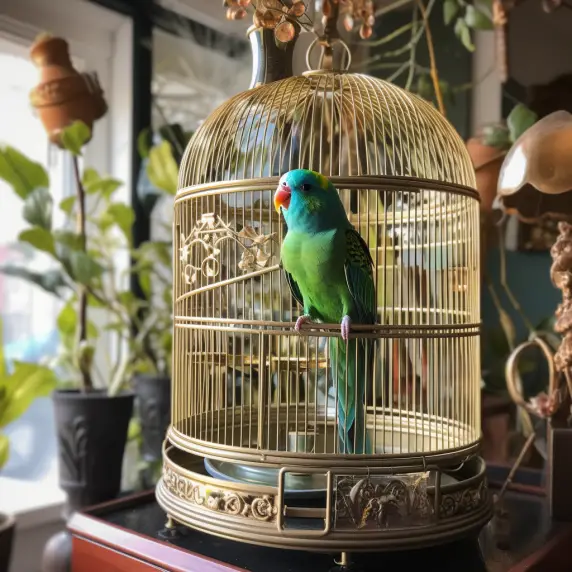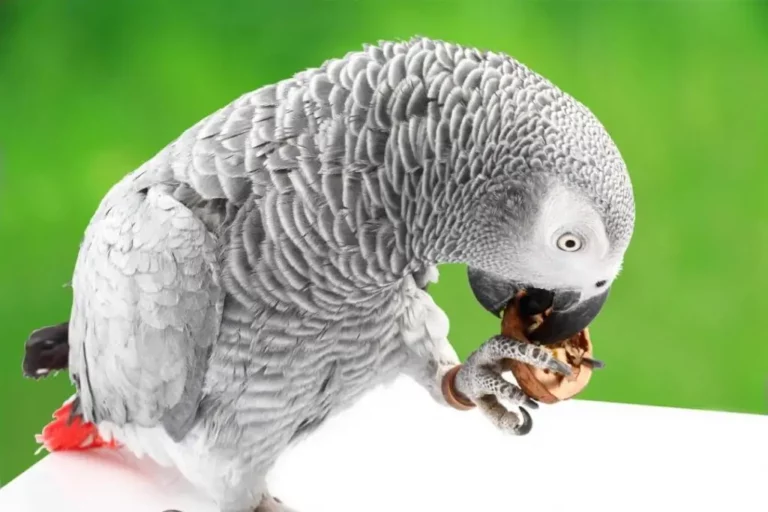10 Pet Birds That Can Talk Like Humans
Welcome to our guide on the fascinating world of talking pet birds! In this comprehensive blog post, we’ll introduce you to 10 incredible bird species that possess the unique ability to mimic human speech.
These talented avian companions not only provide us with endless entertainment, but they also help us understand the remarkable capabilities of animal communication.
So, whether you’re a bird enthusiast or simply curious about the wonders of nature, join us as we explore the extraordinary lives of these captivating birds and learn more about their impressive talking abilities. Get ready to be amazed as we embark on this incredible journey into the world of birds that talk like humans.
Key takeaways
African Grey Parrots, Budgerigars, and Amazon Parrots excel in mimicking human speech.
African Grey Parrots are the top talkers among birds due to their intelligence.
Budgerigars can learn many words and phrases.
Amazon Parrots have a loud, clear voice, especially Yellow-Naped Amazons.
Quaker Parrot, Indian Ringneck, and Eclectus Parrot can talk with consistent training.
Talking ability can vary within species based on personality and human interaction.
Teaching a bird to talk requires patience and positive reinforcement.
Some birds communicate through sounds and gestures, not human speech.
1) African Grey Parrot: The Ultimate Talker
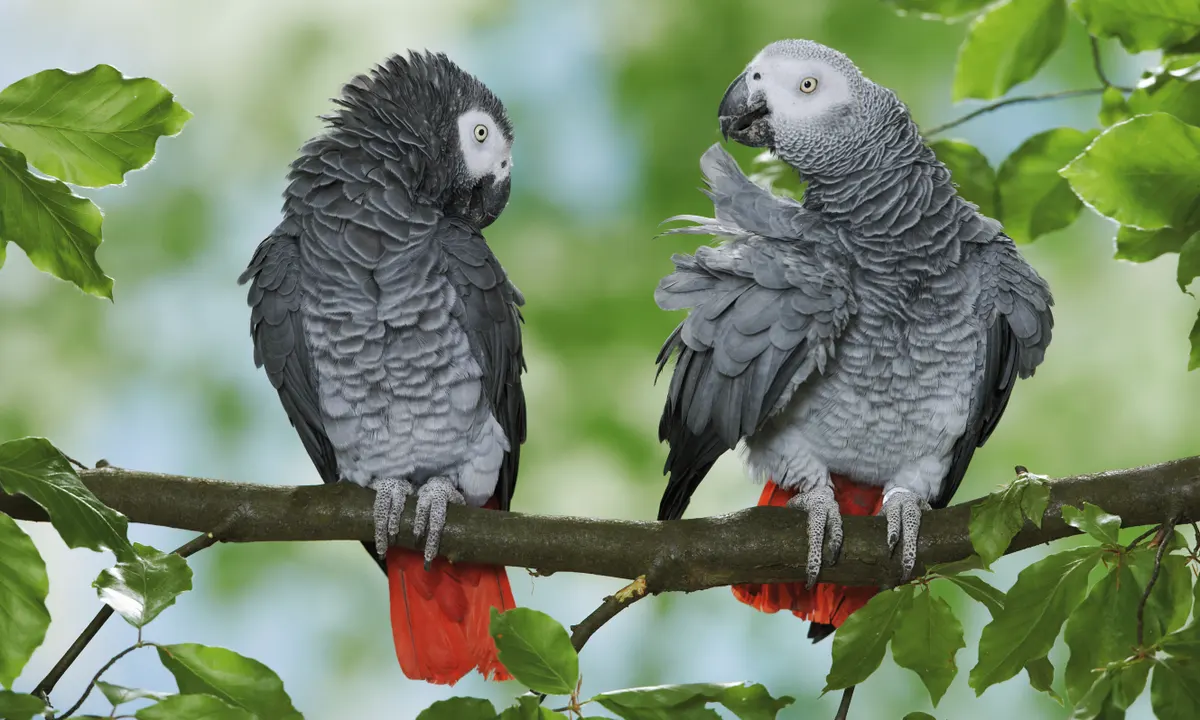
The African Grey Parrot, often regarded as the ultimate talking bird, is renowned for its incredible mimicry and speech abilities.
Hailing from the rainforests of West and Central Africa, these intelligent and social creatures have captivated bird enthusiasts and pet owners alike with their advanced cognitive skills and human-like speech.
African Grey Parrots have been observed to possess vocabularies of over 1,000 words, and some individuals can even understand and use language contextually. This exceptional ability has earned them a reputation as one of the most intelligent bird species in the world.
Their highly developed brain, specifically the area responsible for vocal learning and speech, allows them to process and reproduce a variety of sounds, including human voices, other bird calls, and even mechanical noises.
In addition to their talking prowess, African Grey Parrots are known for their inquisitive and affectionate personalities. They thrive on social interaction and mental stimulation, making them wonderful companions for dedicated and patient owners.
However, it’s essential to provide these sensitive birds with a nurturing environment, proper diet, and plenty of attention to keep them healthy and content.
When considering an African Grey Parrot as a pet, it’s crucial to remember that their impressive talking abilities come with a great deal of responsibility. These birds require a long-term commitment, as they can live up to 50 years or more with proper care.
Nevertheless, the bond formed between these intelligent birds and their human caretakers can be incredibly rewarding, making the African Grey Parrot a truly remarkable talking pet bird.
2) Amazon Parrots: Bold and Colorful Conversationalists
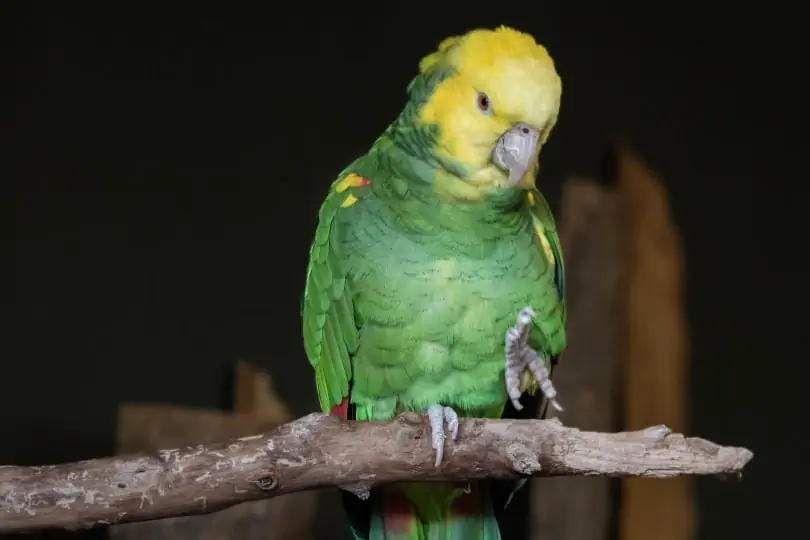
Amazon Parrots are a group of vibrant and charismatic birds native to Central and South America. Known for their striking colors and bold personalities, these parrots have become popular pets among bird lovers for their remarkable ability to talk and mimic human speech.
There are several species of Amazon Parrots, each with its unique characteristics and appearance. However, most species share an aptitude for talking and can develop impressive vocabularies.
Some of the best talkers among Amazon Parrots include the Yellow-naped Amazon, the Blue-fronted Amazon, and the Double Yellow-headed Amazon. These birds are known for their clear speech and can even learn to sing songs with astonishing accuracy.
Socialization plays a significant role in the talking abilities of Amazon Parrots. They are highly social creatures and thrive on interaction with their human caretakers. The more you engage with your Amazon Parrot, the more likely they are to pick up words and phrases.
They may even develop a preference for certain family members and mimic their voices or specific expressions.
It’s important to note that Amazon Parrots can be quite loud, making them potentially unsuitable for those living in apartments or close quarters. Additionally, they require a substantial amount of mental stimulation and physical exercise to stay healthy and happy.
Caring for an Amazon Parrot is a long-term commitment, as they can live up to 50 years or more with proper care. However, their outgoing personalities, captivating colors, and remarkable talking abilities make them a fascinating and entertaining pet bird for those willing to dedicate time and effort to meet their needs.
3) Indian Ringneck Parakeet: The Exotic Chatterbox
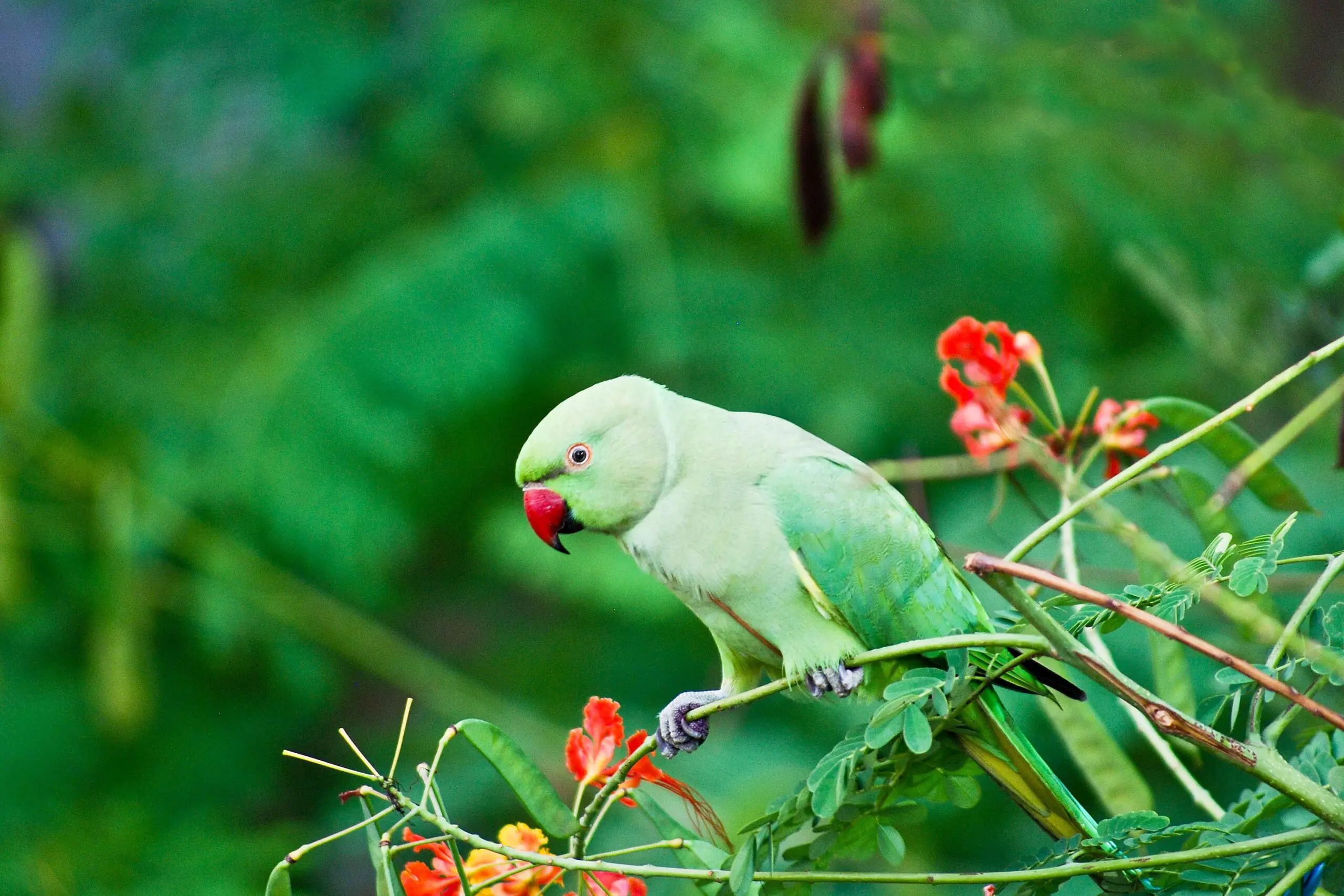
The Indian Ringneck Parakeet is an elegant and exotic bird species originating from Asia and Africa. With their striking plumage, unique ring-like markings around their necks, and impressive talking abilities, these parakeets have become increasingly popular as pets among bird enthusiasts.
Indian Ringneck Parakeets are known for their remarkable ability to mimic human speech with exceptional clarity. Their talking skills are characterized by a distinctive, almost accent-like quality that sets them apart from other talking birds.
They can develop extensive vocabularies and have been known to learn over 200 words and phrases.
These captivating birds are not only skilled talkers but also display a diverse range of vocalizations. Indian Ringnecks can mimic various sounds from their environment, such as other birds, electronic devices, and even laughter.
They are also known for their longevity, with a lifespan of up to 30 years or more when properly cared for.
When it comes to their personality, Indian Ringneck Parakeets are known for being independent, intelligent, and playful. They enjoy human interaction and can form strong bonds with their owners.
However, it’s essential to provide them with proper socialization and stimulation to prevent boredom and the development of behavioral issues.
To help your Indian Ringneck Parakeet thrive and encourage their talking abilities, offer them a spacious and enriching environment with plenty of toys and perches, as well as a well-balanced diet.
With the right care and attention, these exotic birds can become affectionate and engaging companions, making the Indian Ringneck Parakeet a delightful addition to any home that appreciates their unique talking talents.
4) Eclectus Parrot: The Bilingual Beauty
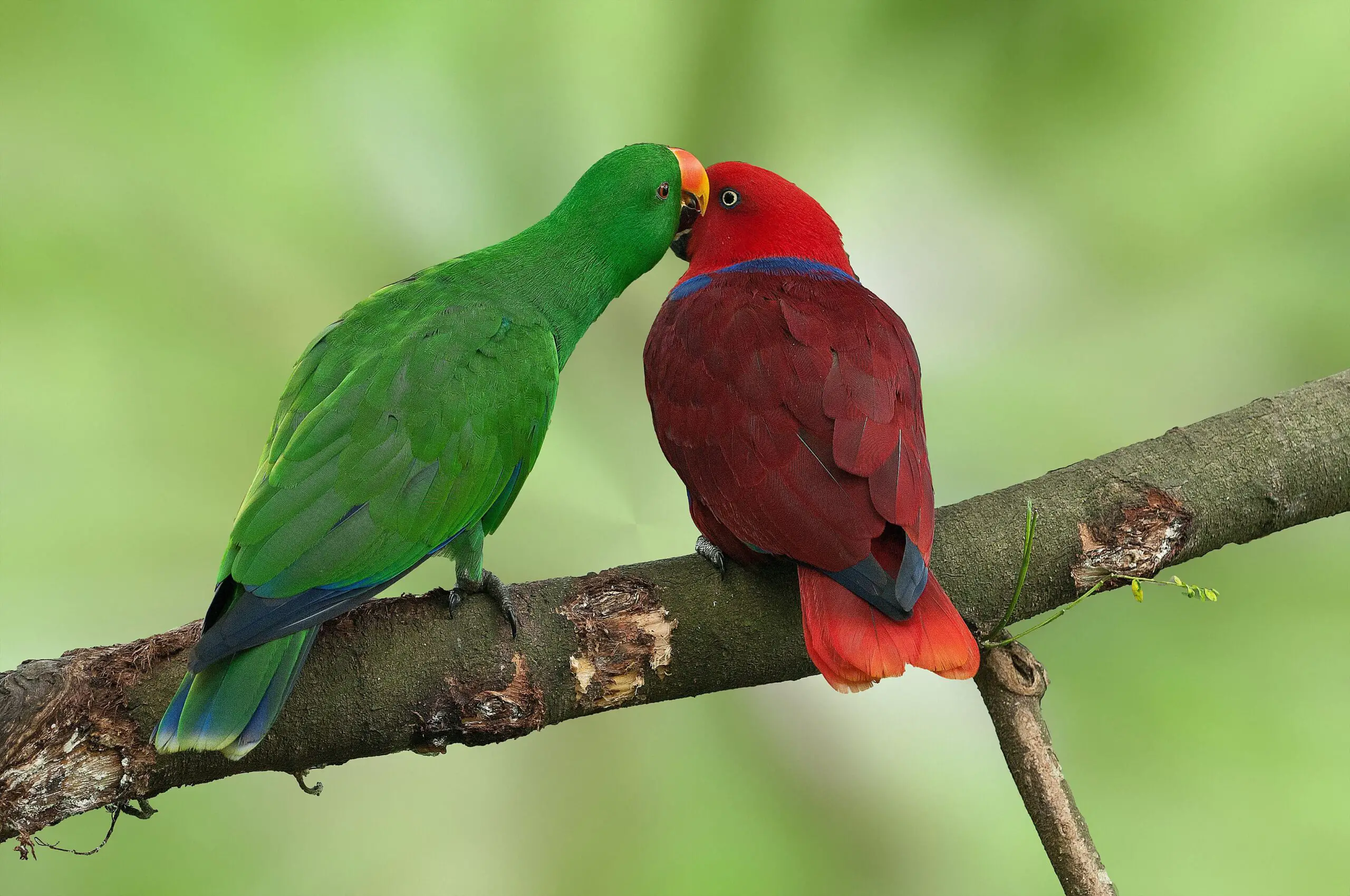
Eclectus Parrots are visually stunning birds, known for their strikingly vibrant colors and distinct sexual dimorphism – males are bright green, while females boast a brilliant red and purple plumage.
Hailing from the rainforests of Australia, New Guinea, and the Solomon Islands, these exotic parrots have captured the hearts of bird enthusiasts with their gentle demeanor and exceptional talking abilities.
One fascinating aspect of the Eclectus Parrot’s talking skills is their potential to become bilingual. Some individuals have been known to learn and mimic speech in two languages, making them stand out among other talking bird species.
Their speech is characterized by a clear, almost human-like quality, and they can develop an impressive vocabulary.
Eclectus Parrots are known for their easy-going, friendly nature, which makes them delightful pets for families or individuals who are willing to invest time in their care. They thrive on social interaction and are generally more docile than some other parrot species, which can make them easier to handle and train.
To encourage your Eclectus Parrot to talk, engage with them regularly and provide a variety of stimulating toys and activities. Additionally, a well-balanced diet and a spacious, clean environment are crucial for their overall health and well-being.
When considering an Eclectus Parrot as a pet, keep in mind that they have a long lifespan of up to 40 years or more.
This long-term commitment, coupled with their captivating beauty and exceptional talking skills, makes the Eclectus Parrot a unique and rewarding pet bird for those dedicated to providing them with a loving, attentive home.
5) Quaker Parrot: The Small but Mighty Talker
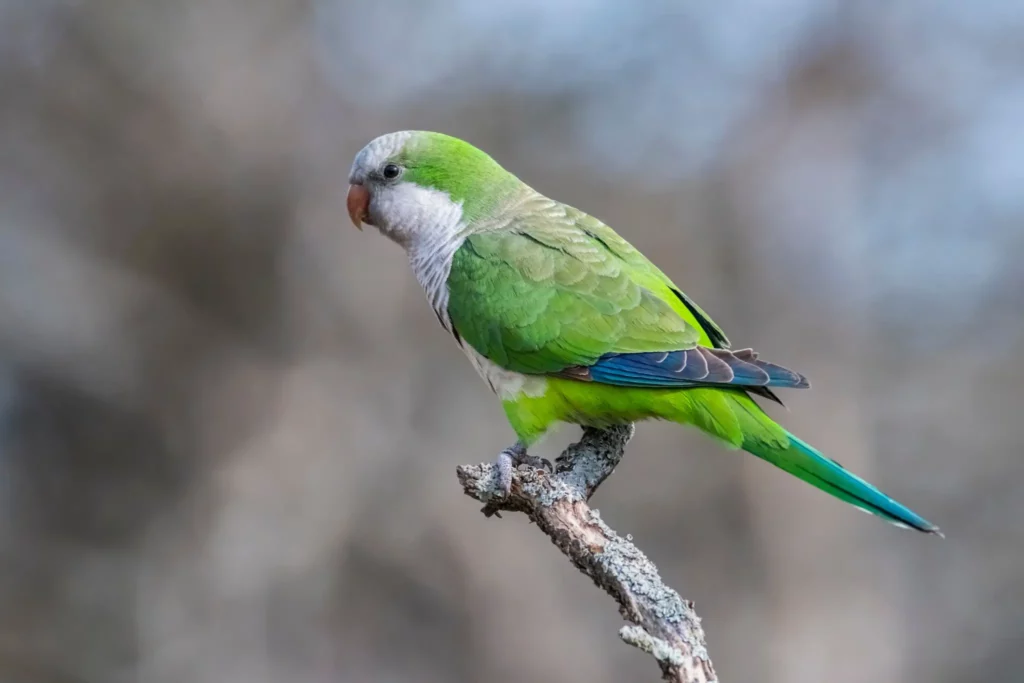
The Quaker Parrot, also known as the Monk Parakeet, is a small and charming bird native to South America. With their bright green plumage and energetic personalities, these compact parrots have become increasingly popular as pets, particularly for their impressive talking abilities and penchant for mimicking sounds.
Despite their small size, Quaker Parrots are skilled talkers and can learn a surprisingly large vocabulary. Their speech is characterized by a distinct, high-pitched tone, which adds an endearing quality to their mimicry.
These parrots are also adept at imitating various environmental sounds, such as doorbells, alarms, and even other pets.
Quaker Parrots are intelligent, social creatures that thrive on interaction and mental stimulation. They have a playful and curious nature, which can make them entertaining and engaging companions.
To encourage talking in your Quaker Parrot, spend time interacting with them daily, repeating words and phrases, and using positive reinforcement to reward their efforts.
Although they are small, Quaker Parrots require ample space to move and explore, as well as a variety of toys and perches to keep them entertained. Providing a balanced diet and a clean environment are also essential for their health and well-being.
With proper care and attention, Quaker Parrots can live up to 20 years or more, making them a long-term commitment for any potential owner. Their small size, lively personalities, and remarkable talking abilities make them an excellent choice for those seeking a compact, yet entertaining, avian companion.
6) Budgerigar: The Pocket-Sized Polyglot
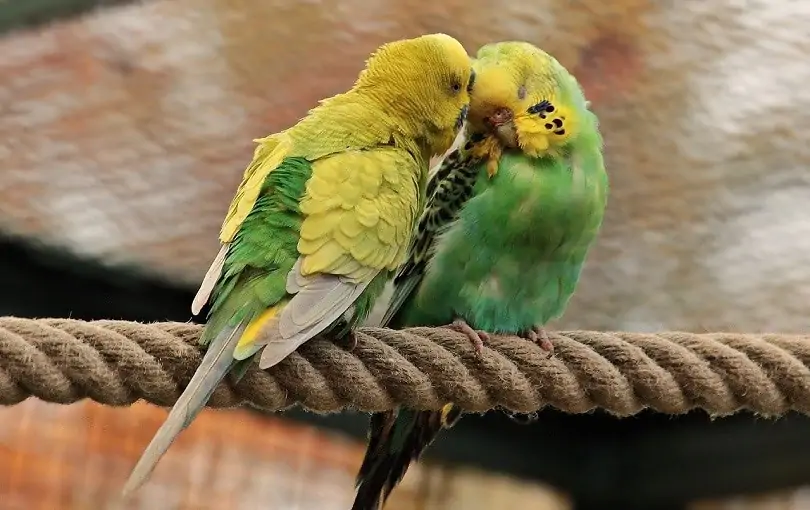
Budgerigars, commonly known as budgies or parakeets, are small, colorful birds native to Australia. Their friendly nature, ease of care, and affordable price make them one of the most popular pet birds worldwide.
Although their talking abilities might not be as advanced as some larger parrot species, budgies have the potential to become quite the chatterboxes.
These pint-sized parrots are capable of learning a significant number of words and phrases, with some individuals boasting vocabularies of over 100 words. Their speech tends to be fast and high-pitched, which can make it challenging to understand at times.
However, with patience and dedication, owners can help their budgies develop clear and distinct speech.
Budgies are social creatures and require regular interaction to encourage their talking abilities. By engaging with your budgie consistently and repeating words or phrases, you can help them learn to mimic human speech. Additionally, offering praise and positive reinforcement will motivate them to practice their new vocal skills.
To ensure a happy, healthy budgie, provide a spacious cage, a well-balanced diet, and plenty of toys for mental stimulation. It’s essential to remember that while budgies are relatively low-maintenance compared to larger parrots, they still require time and attention to thrive.
With a lifespan of 10 to 15 years, budgies are a more manageable commitment than some of the larger talking bird species. Their compact size, bright colors, and charming talking abilities make them an excellent choice for first-time bird owners or those seeking a smaller, yet communicative, avian companion.
7) Yellow-Naped Amazon: The Melodic Maestro
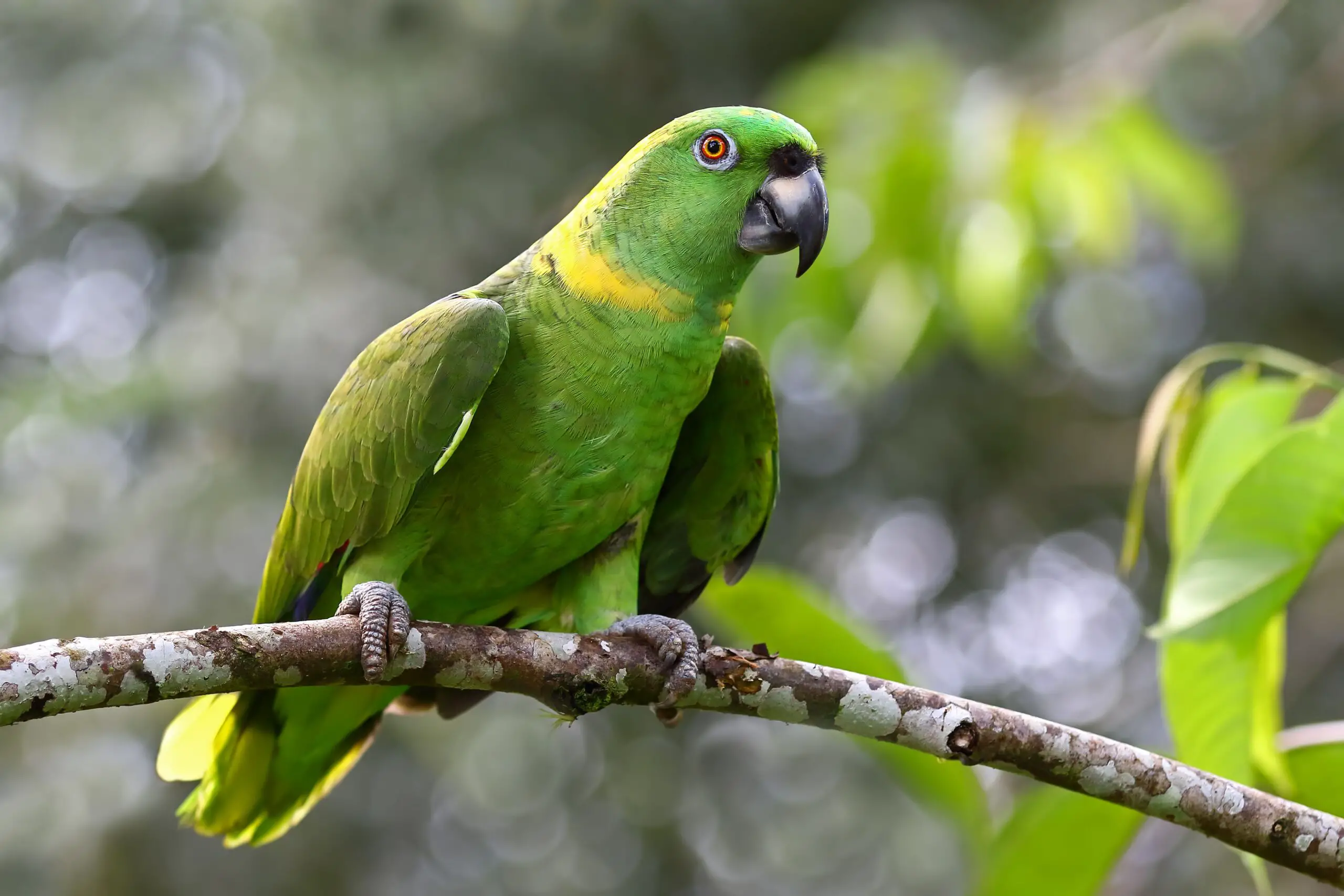
The Yellow-Naped Amazon is a stunning parrot species native to Central America, prized for its vibrant green plumage and distinctive yellow nape. These medium-sized parrots are not only visually striking but also possess extraordinary talking abilities, often being considered among the best talkers in the Amazon Parrot family.
What sets Yellow-Naped Amazons apart from other talking birds is their incredible talent for mimicking songs and melodies. They have a natural affinity for music and can learn to reproduce tunes with remarkable accuracy.
In addition to their musical prowess, these parrots can develop extensive vocabularies and are known for their clear, human-like speech.
Yellow-Naped Amazons are intelligent, social creatures that form strong bonds with their human caretakers. They thrive on attention and interaction, which helps encourage their talking and singing abilities.
To stimulate your Yellow-Naped Amazon’s vocal skills, engage with them regularly, expose them to music, and use repetition and positive reinforcement to foster their learning.
It’s important to keep in mind that these parrots can be quite loud and require a spacious environment, ample mental stimulation, and a balanced diet to maintain their health and happiness. Yellow-Naped Amazons can live up to 60 years or more, making them a long-term commitment for potential owners.
For those who appreciate the beauty of music and the captivating charm of a talking bird, the Yellow-Naped Amazon offers an unmatched combination of melodic talent and linguistic prowess, making them a truly enchanting avian companion.
8) Cockatoo: The Whimsical Performer
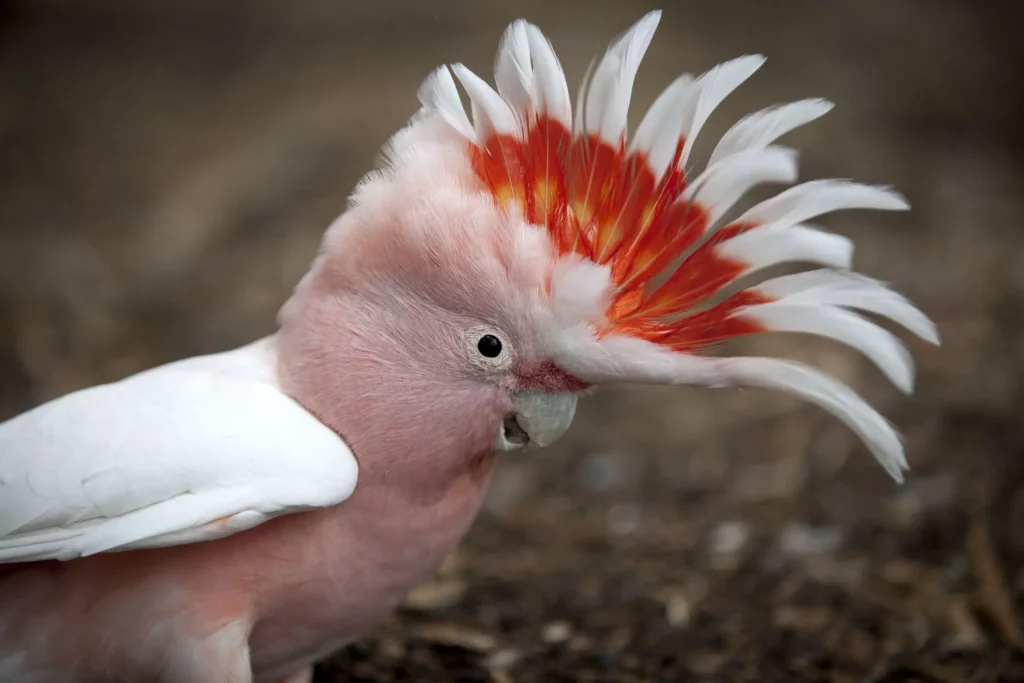
Cockatoos, native to Australia and the islands of Southeast Asia, are large, charismatic birds known for their striking appearance, expressive crest, and boisterous personalities.
While their talking abilities may not be as advanced as some other parrot species, they still possess a unique talent for mimicry and are known for their entertaining performances.
Cockatoos can learn a modest number of words and phrases, often mimicking speech with a distinct and comical tone. Their true talent, however, lies in their ability to imitate various sounds and noises from their environment.
Cockatoos are known for their playful antics, and their vocal mimicry often becomes a part of their performances, much to the delight of their owners.
These birds are highly social, intelligent, and require regular interaction to develop their talking skills and maintain their mental well-being. Spending time with your cockatoo, using repetition and positive reinforcement, will encourage their vocal abilities and strengthen the bond between you.
Caring for a cockatoo requires a spacious living environment, plenty of mental and physical stimulation, and a well-balanced diet. These birds can live up to 40 years or more, making them a significant commitment for potential owners.
Cockatoos may not be the most accomplished talkers, but their whimsical nature, entertaining performances, and endearing mimicry make them a beloved pet for those who appreciate their unique charm and lively spirit.
9) Macaw: The Vibrant Raconteur
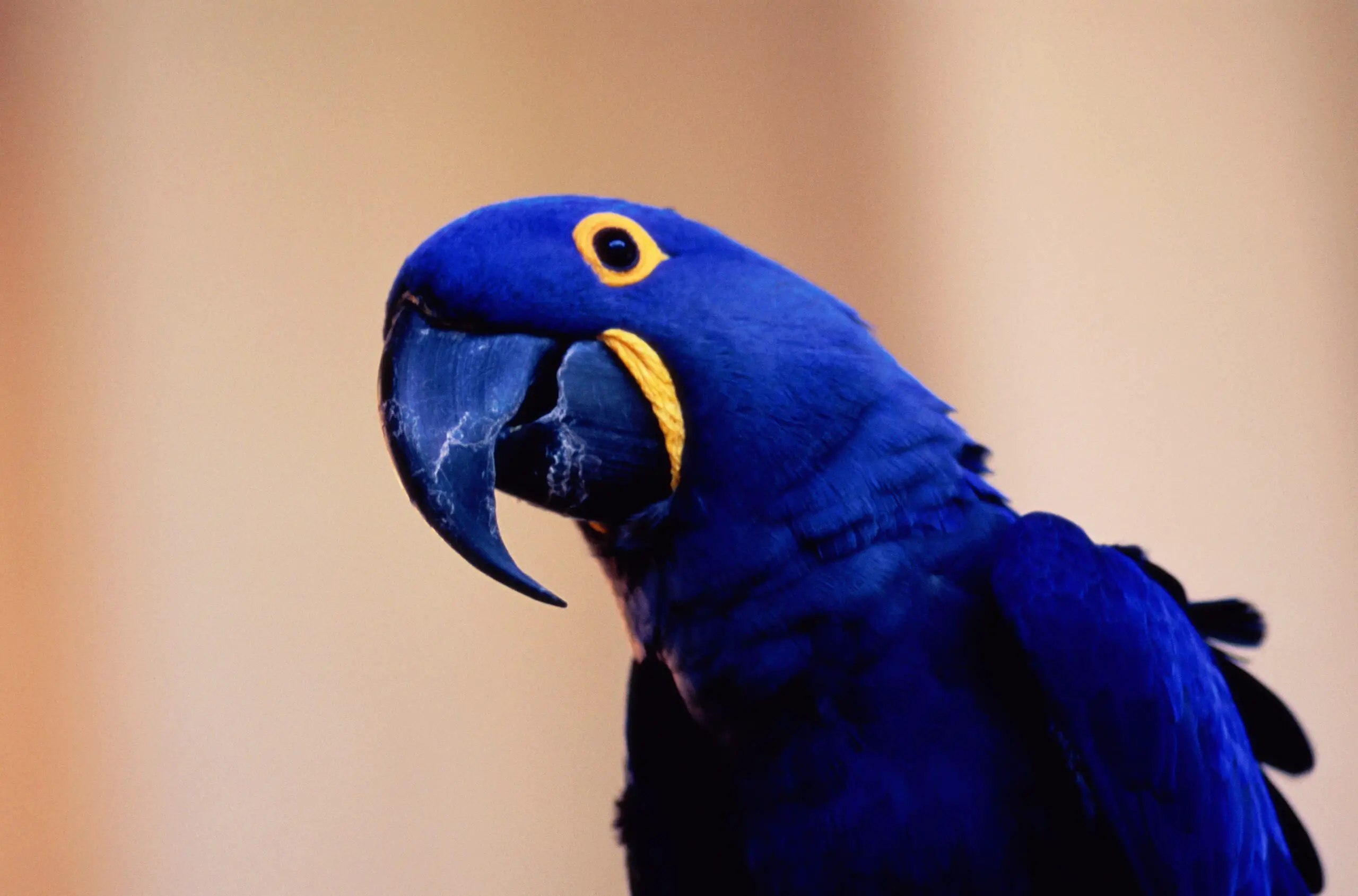
Macaws are large, magnificent birds native to Central and South America, known for their striking colors, impressive size, and captivating personalities.
While their talking abilities may not be as advanced as African Greys or Amazon Parrots, they can still learn to mimic human speech and a variety of other sounds, making them a delightful talking pet bird.
Some of the more talkative macaw species include the Blue and Gold Macaw, the Scarlet Macaw, and the Green-Winged Macaw. These parrots can learn a modest number of words and phrases and are known for their loud, boisterous vocalizations.
They are also adept at imitating environmental sounds, such as other animals, appliances, and even laughter.
Macaws are highly intelligent and social creatures that thrive on interaction with their human caretakers. Spending time with your macaw, engaging in play and conversation, will help them develop their talking skills and foster a strong bond between you.
Caring for a macaw requires a spacious living environment, as well as plenty of mental and physical stimulation to keep them entertained and healthy. A well-balanced diet is also essential for their well-being.
Macaws have a long lifespan, with some individuals living up to 60 years or more, making them a significant commitment for potential owners.
For those who appreciate the awe-inspiring beauty and charismatic personalities of these vibrant parrots, the Macaw offers a unique talking bird experience, enchanting their owners with their lively vocalizations and captivating presence.
10) Hill Myna: The Feathered Linguist
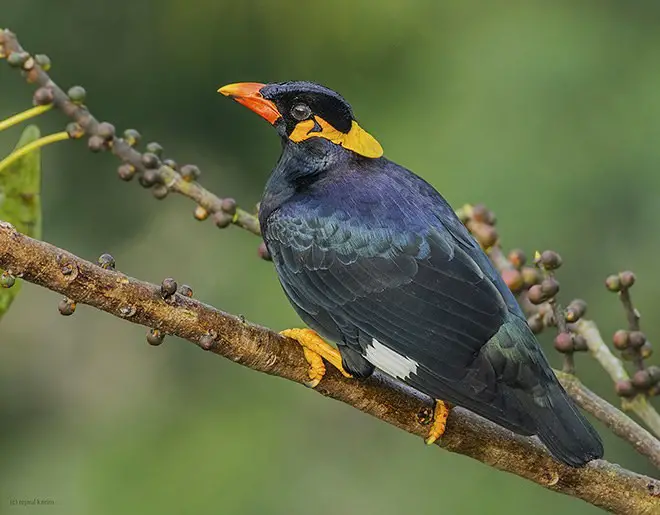
The Hill Myna is a medium-sized, glossy black bird native to Southeast Asia, known for its distinctive yellow wattles and brilliant white wing patches.
While not a parrot species, the Hill Myna has earned a reputation as a talented talking bird, with an extraordinary ability to mimic human speech and a wide range of sounds with incredible accuracy.
Hill Mynas are often considered among the best talking birds outside the parrot family. Their speech is characterized by a clear, human-like quality that is both remarkable and captivating.
They can develop impressive vocabularies and are even capable of reproducing various dialects, accents, and intonations, making them a unique and fascinating avian companion.
These intelligent birds thrive on interaction and mental stimulation, which is essential for encouraging their talking abilities. Engaging with your Hill Myna regularly, using repetition and positive reinforcement, will help them develop their vocal skills and form a strong bond with you.
Caring for a Hill Myna requires a spacious living environment, a well-balanced diet, and plenty of toys and perches for mental enrichment. With proper care, these birds can live up to 20 years or more, making them a long-term commitment for potential owners.
For those seeking a talking bird that is both visually striking and linguistically talented, the Hill Myna offers a unique and engaging experience, mesmerizing their owners with their stunning mimicry and unmatched vocal abilities.
Frequently Asked Questions
How can birds talk like humans?
Birds can talk like humans because of their unique vocal anatomy and their ability to learn and mimic sounds. The primary vocal organ in birds, called the syrinx, is located at the base of their trachea. This structure allows them to produce a wide range of sounds, including mimicking human speech.
Some bird species, particularly those in the parrot family, have a greater ability to mimic human speech due to their advanced vocal anatomy and higher cognitive abilities.
These birds have more developed syrinxes and brain areas responsible for learning and vocalization, which enable them to learn and reproduce a variety of sounds, including human speech.
Birds like parrots and mynahs can learn to talk by listening to and mimicking the sounds they hear in their environment. They often form a strong bond with their human caretakers, allowing them to pick up words and phrases used in daily interactions.
It’s important to note that not all birds have the ability to talk or mimic human speech, but the ones that can do so through a combination of their unique anatomy and learning abilities.
Why can parrots talk but not monkeys?
Parrots can mimic human speech, while monkeys cannot, mainly due to differences in vocal anatomy, vocal learning abilities, and the way they process and produce sounds.
- Vocal anatomy: The primary vocal organ in birds is called the syrinx, which is located at the base of their trachea. This structure allows them to produce a wide range of sounds, including mimicking human speech. On the other hand, monkeys have a larynx as their vocal organ, which is not as specialized or flexible as the syrinx, making it more difficult for them to reproduce the complex sounds of human speech.
- Vocal learning abilities: Parrots and some other bird species possess a unique ability for vocal learning, which means they can listen to sounds in their environment and accurately reproduce them. This ability is supported by specialized neural circuits in their brains that enable them to process and imitate sounds. Monkeys, although intelligent and capable of complex communication through gestures and vocalizations, do not have the same level of vocal learning abilities as parrots.
- Sound processing and production: Parrots have a higher degree of control over their vocal organs, allowing them to modulate pitch, volume, and rhythm to closely mimic human speech. Monkeys, on the other hand, have a more limited vocal repertoire and less control over their vocalizations, making it difficult for them to imitate the intricate sounds of human speech.
While monkeys cannot mimic human speech as parrots can, they are still intelligent and social animals that can communicate effectively with each other and their human caretakers using body language, facial expressions, and vocalizations.
Final Thoughts
The world of talking birds is as diverse and fascinating as the species that inhabit it. From the unparalleled linguistic skills of the African Grey Parrot to the melodic prowess of the Yellow-Naped Amazon, each bird offers a unique and captivating experience for their owners.
While some species may be more talented talkers than others, all of them have the potential to bring joy, companionship, and endless entertainment to their human caretakers.
When choosing a talking bird, it’s essential to consider factors such as the bird’s specific needs, the level of commitment required, and the type of interaction and stimulation they need to thrive.
With the right care and attention, these remarkable creatures can become lifelong companions, enriching your life with their presence and their extraordinary ability to talk like humans. Embrace the enchanting world of talking birds and discover the endless possibilities that these talented, feathered friends have to offer.

